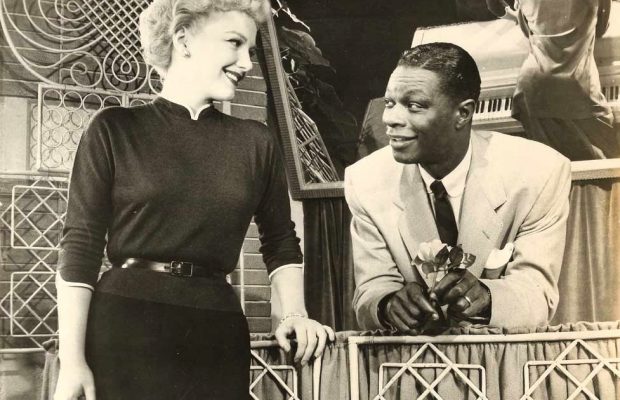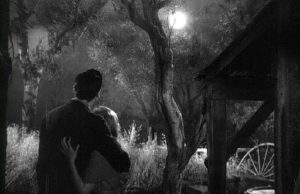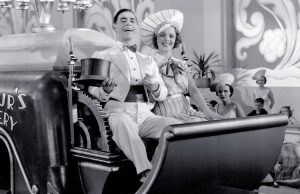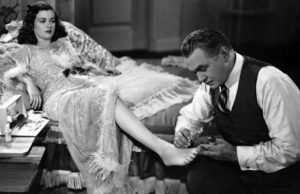The Blue Gardenia (1953)

Toronto Film Society presented The Blue Gardenia (1953) on Sunday, April 2, 2017 in a double bill with Slightly Scarlet as part of the Season 69 Sunday Afternoon Film Buff Series, Programme 7.
Production Company: Blue Gardenia Productions, distributed by Warner Brothers. Producer: Alex Gottlieb. Director: Fritz Lang. Screenplay: Charles Hoffman, based on the short story “Gardenia” by Vera Caspary. Cinematography: Nicholas Musuraca. Art Direction: Charles D. Hall (as Daniel Hall). Film Editor: Edward Mann. Release Date: November 9, 1953.
Cast: Anne Baxter (Norah Larkin), Richard Conte (Casey Mayo), Ann Southern (Crystal Carpenter), Raymond Burr (Harry Prebble), Jeff Donnell (Sally Ellis), Richard Erdman (Al), George Reeves (Police Captain Sam Haynes), Ruth Storey (Rose Miller), Ray Walker (Homer), Nat King Cole (Nat “King” Cole).
Fritz Lang was blacklisted during the McCarthy era. Lang had been placed on the Black List due to his friendship with a number of well-known Marxists such as Bertolt Brecht and had hired supposed left-wingers Ring Lardner Jr. and Albert Maltz to write the screenplay for his 1946 film Cloak and Dagger. However, two different sources, Lotte H. Eisner’s 1977 and Patrick McGilligan’s 1997 biographies claim that the director was affected for two different lengths of time by the ban. In Eisner’s book, she claims it was after 18 months of enforced idleness that Lang was approached by a producer named Adolf Gottlieb with the title The Blue Gardenia which had been suggested to him by a prostitute who had recently been brutally murdered with the pseudonym “Black Dahlia”. In McGilligan’s book, he writes that Lang was at work on his previous film Clash By Night as late as the last week of March 1952, was blacklisted for no more than six months, putting him back working on pre-production of The Blue Gardenia by mid-October of the same year. But no matter, because six months between films was considered the standard break for Fritz Lang anyway. And it was Harry Cohn of Columbia who testified before the House on Un-American Activities Committee that Lang had never been a member of the Communist party which enabled him to work again.
In Eisner’s biography, she says that apart from The Blue Gardenia serving as a work project for Lang, he had no real affection for the film. It had to be shot in twenty days which left little time for the preparation and revision of the script, though he was able to modify the dialogue and, in one important particular, the action. Nor did it have the kind of social message which he preferred. For all that, the film is remarkably vivid and substantial, with the world of the telephone exchange in the world of three women living in a tiny apartment.
Jans B. Wager says in her book Jazz and Cocktails: Rethinking Race and the Sound of Film Noir, that The Blue Gardenia featuring Nat King Cole in an oddly discrete musical sequence where he croons the title song, is a sequence that exemplifies a type of alienation effect. He and his three black band members seem to exist in a realm entirely separate from the world of the film, although the music is nominally being performed by him in the nightclub that gives the film and the locale its name.
Filmmakers experienced intense pressures during the two rounds of the HUAC hearings that targeted Hollywood. Researchers discuss Lang’s sense that he had been “grey-listed,” not officially blacklisted, but not employed either. For researcher Janet Bergstrom, “deception, betrayal and psychological terrorism thoroughly penetrate this McCarthy-era film…a nightmare from one end to the other.” The nightclub sequence is no exception.
The sequence in the Blue Gardenia club accomplishes a stereotypical narrative function of jazz in film noir, despite “the Polynesian restaurant” setting and Cole singing “smooth as velvet, decked out like a cabana boy.” Jazz writer Krin Gabbard suggests that “the choice of a black jazz artist to introduce the title song is ideologically appropriate…in spite of the syrupy, nonjazz arrangement” of the song, as “Cole’s presence [nevertheless] carried associations…linked…with loose sexuality and drug abuse.”
Only one character, May, an older blind woman played by Celia Lovsky, selling blue gardenias to the club patrons, connects the singer to the restaurant. Lovsky, who incidentally played the ruler of the planet Vulcan on Star Trek, had been married to Jewish actor Peter Lorre and fled Germany with him as the Nazis came to power. As the blind flower seller, she steps incongruously into a shot of Cole at the keyboard and places a gardenia on the piano. Cole appears to watch her and to respond to the audience, but the sequence seems cobbled together, as though Cole never shared the studio space with the actors. It should be interesting to take note of how this appears to us when Cole comes on the scene.
Introduction by Caren Feldman
Plot: Nora Larkin (Baxter) is a pretty telephone operator engaged to a soldier overseas. On her birthday, she gets a “Dear John” letter from him, ending their engagement. Feeling despondent, she agrees to a date with an unsavoury character from her office. He gets her drunk and leads her back to his apartment, where she resists his advances and bludgeons him in self-defence. She flees, leaving behind the blue gardenia he had bought her. The next morning, she can’t remember the details of what happened.
Critical Reception: This was the first of Lang’s three “newspaper noir” movies made towards the end of his career in America; the others being While the City Sleeps and Beyond a Reasonable Doubt. The initial reception from Variety, among others, was lukewarm, filled with comments like “stock story”, “regulation mystery melodrama”, “formula development with an occasional bright spot”, and “Baxter and Conte do what they can, but fight a losing battle with the script”. A more recent critic calls it “a minor film noir” with “a dull script that plays as an unimaginative newspaper melodrama that takes jabs at the middle class and how neurotic and fearful they are about romance.” The film’s main defender has been critic and fellow director Peter Bogdanovich, who has called it “a particularly venomous picture of American life” (presumably intended as a compliment).
Fritz Lang (1890-1976): Born in Vienna and raised as a Catholic by his parents, he studied architecture and then art at university, and travelled widely in Europe, Africa, Asia, and the Pacific as a young man. After volunteering for military service in World War I and being wounded three times, he worked briefly for the theatre before being hired as a scriptwriter and then director for the German film company UFA, just as the Expressionist movement was getting under way. He quickly gained an international reputation for his work in Germany in the 1920s with such silent films as his two Dr. Mabuse titles (1922 and 1933) and Die Niebelungen (1923-24), though his most ambitious and expensive work of the period, Metropolis (1925-26), was at first a huge box-office flop and cut to ribbons, in most countries, in an attempt to make it commercially viable. Painstaking reconstructions of the film in recent years, however, have made it one of the most admired and widely screened of all silent films. His first sound film, M (1931), a powerful study of a serial child killer, but also an indictment of uncontrolled mob justice, was internationally acclaimed for its imaginative use of the new medium and was highly influential. [A shot of a child’s ball bouncing down a flight of steps in the US-made film Cloak and Dagger deliberately recreates a famous moment in M.]
By his own perhaps unreliable account, he later claimed that, despite his strongly anti-Nazi politics, he was offered the position of head of the main German film studio UFA by Hitler’s propaganda minister, Joseph Goebbels, in 1934, following which he promptly left Germany for France, leaving behind his wife and frequent scriptwriter, Thea von Harbou, who was a fervent supporter of the Nazis. There he made one film, Liliom, before accepting an offer from MGM and moving to Hollywood, where he stayed until 1957, when he returned to Germany and made two final films. In the US, he was one of many eminent film directors, novelists, musicians, and playwrights who had emigrated from Nazi Germany and Nazi-occupied France. Among the filmmakers were Jean Renoir, René Clair, Max Ophuls, Billy Wilder, Otto Preminger, and Robert Siodmak. Between them, they made an immense contribution to American cinema of the 1940s and 1950s, especially in the areas of film-noir, socially- or politically-themed thrillers, and (in Lang’s case) unorthodox Westerns. Some of his films, such as Hangmen Also Die and Cloak and Dagger, were explicitly anti-Nazi, and his 22 American films include such masterpieces as Fury (1936), The Woman in the Window (1944), Scarlet Street (1945), The Big Heat (1953), and While the City Sleeps (1955). Critical opinion at the time was often lukewarm towards these films, seeing them as little more than standard melodramas, but many of them are now acknowledged as major works of the period.
Throughout his career, Lang’s visual style was highly (some critics say coldly) geometrical, relying on carefully composed and framed compositions, and elaborate play of light and shadow. Clocks and doorways are recurrent images that take on overtones of menace and inexplicable anxiety, and themes of paranoia, pursuit, mistaken identity, wrongful accusation, disguise, foreboding, and violent retribution–usually presented in grittily realistic fashion–are common.
Anne Baxter (1923-1985): Granddaughter of architect Frank Lloyd Wright, she developed an early interest in the stage and made her first appearance on Broadway at the age of 13. She made her film début in 1940 and signed a contract with 20th Century Fox. Baxter appeared for Fox and other studios in The Magnificent Andersons (1942) and Five Graves to Cairo (1943), and won the Academy Award for Best Supporting Actress for The Razor’s Edge in 1946. She played Eve Harrington in All About Eve (1950) and moved to Warner Brothers in 1953, where she made I Confess for Alfred Hitchcock and then had a starring role in Cecil B. DeMille’s Ten Commandments in 1956. She worked regularly on television in the 1960s, and returned to the stage for Applause, the musical version of All About Eve, where she played the role that Bette Davis had in the film. She married three times, was politically a Republican, and died at the age of 62.
Richard Conte (1910-1975): He worked on a variety of jobs before being discovered as an actor by Elia Kazan and John Garfield, leading to study at the Neighborhood Playhouse in New York. After some stage appearances, he made his first film in 1939 and appeared in several war movies in the 1940s, including A Walk in the Sun (1945). Conte then became “a key actor in noir films”, such as Thieves’ Highway (1949) and Whirlpool (1949). He made a series of noir films in the 1950s, including The Big Combo and The Brothers Rico, as well as the Susan Hayward melodrama I’ll Cry Tomorrow (1955). He appeared frequently on TV in the 1960s before moving to Europe, appearing in several films there as well as in The Godfather (1972).
Ann Sothern (1909-2001): Born Harriette Arlene Lake, her early interest and talent was for music and later for theatre, where she was offered work by Florenz Ziegfield after some unsatisfying small roles for MGM. She then signed a contract with Columbia, who changed her name to Ann Sothern, but used her mainly in B-movies. She next signed with RKO and then went back to MGM, where she finally found major success with Maisie (1939), followed by several comic sequels and, in 1949, A Letter to Three Wives. She received excellent reviews for the film, though her career began to falter, afterwards. MGM cancelled her contract when she fell ill with hepatitis. By the 1950s, she was working only in supporting roles and, more frequently, television, in series such as Private Secretary and The Ann Sothern Show. When the latter show was cancelled, she returned to the cinema in The Best Man (1964) and Lady in a Cage (1965), but spent the bulk of her later career in TV. She had a final film role in The Whales of August, along with Lillian Gish and Bette Davis, in 1987, before retiring from acting.
Raymond Burr (1917-1993): Born in New Westminster, British Columbia, he moved to California after his parents divorced and attended a military academy for a while, though many other supposedly biographical details were apparently invented by him later. He began an acting career in 1937, and had his first Broadway role in 1941, after which he became a contract player for RKO, appearing as a film-noir villain in Anthony Mann’s Raw Deal (1947), followed by a similar role in Pitfall (1948). His best later film performances were in A Place in the Sun (1951) and especially Rear Window (1954). His later career, however, was mostly in TV, where he became famous as Erle Stanley Gardner’s Perry Mason, from 1957 to 1966–for which he won two Emmy Awards–and then Ironside, from 1967 to 1975, for which he received several Emmy nominations. Later series were less successful, though he worked regularly in television and occasionally in film until shortly before his death. Information about his private life is often suspect or unverifiable, though it was widely known in Hollywood that he was homosexual.
Nicholas Musuraca (1892-1975): One of the now most highly regarded of Hollywood cinematographers, after years spent in obscurity, in particular for his development of the characteristic visual style of film-noir, based on darkness and shadows. Major films were Bedlam, Cat People, Out of the Past, Blood on the Moon, Clash By Night, The Locket, The Spiral Staircase, The Seventh Victim, Born to Be Bad, and The Mad Miss Manton. One critic has summed up his work as follows: “With darkness and light as his instruments, Musuraca charted the topography of menace with unparalleled consistency and artistry.”
Very Caspary (1899-1987): A major writer of mystery and crime fiction in the 1940s and 1950s whose work was often filmed by Hollywood, most notably Laura (1944) and A Letter to Three Wives (1949).
Notes by Graham Petrie













Leave a Reply